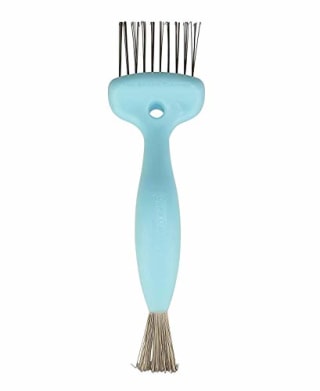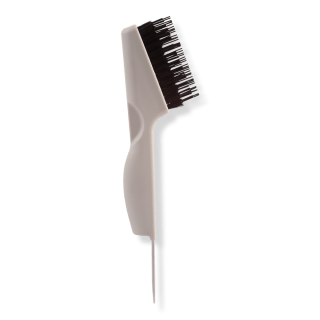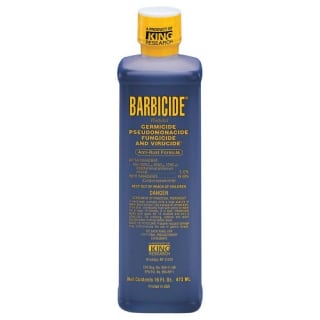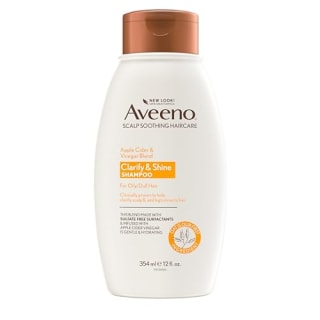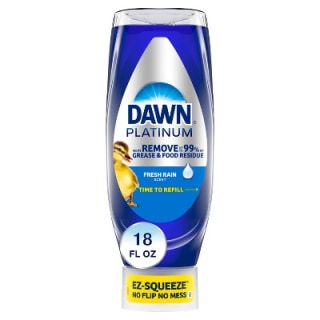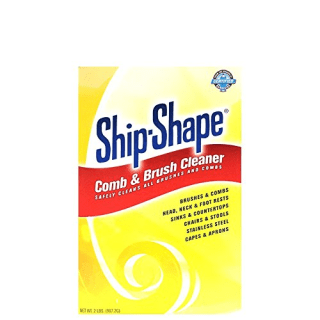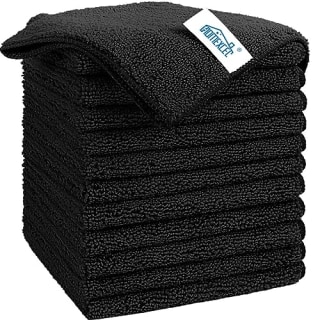This will sound gross, but I’ve never deep cleaned my hairbrushes and combs. Sure, I’ve cleaned out the trapped hair that gets on the brush after I use it, but I’ve never done anything more than that. Turns out, that’s not really enough. After speaking with experts for this story, I learned that thoroughly giving your brushes a deep clean (via six specific steps, which I’ll outline in more detail below) not only improves the longevity and function of your tools, but it also helps keep your hair and scalp healthy. “When you clean your brush/comb, you remove product buildup, dead skin cells, and hair strands that may be stuck to it, ensuring that they don’t transfer back onto your hair the next time you use the brush/comb,” says Jae Manuel Cardenas, a senior hairstylist at Sally Hershberger NoMad.
I spoke to three hairstylists about the best products to help you achieve a deep clean, and also break down how often you should clean your brush and when it’s the right time to replace it.
SKIP AHEAD How do you clean hair brushes? | Best products to clean hair brushes and combs | How do you clean combs? | Why trust NBC Select?
Want more from NBC Select? Sign up for our newsletter, The Selection, and shop smarter.
How should you properly clean hairbrushes?
Although there are many types of hair brushes, including paddle brushes and round brushes, you can generally clean them the same way, according to our experts.
- Remove hair. Pull out any trapped hair from your brush using your fingers, rat tail comb or wire brush cleaner. You’ll want to do a raking motion to pull out all the hair, according to Liz Moirano, hairstylist and owner of Rooted Mane, a hair salon in northern Virginia. Doing this is extremely important because it makes cleaning more effective, according to Cardenas.
- Apply a warm, soapy water blend to the bristles. Mixing warm water with clarifying shampoo or dish soap will create a cleansing agent that can break down oils and product residue from your brush. You can fully submerge metal or ceramic brushes in this mixture. With paddle, wooden or boar bristle brushes, you should only dip the bristles into the mixture to prevent damaging the brush’s cushion.
- Scrub the bristles. To continue giving it a deep clean, you can take an old toothbrush to scrub the bristles and reach between them to remove any hidden debris.
- Rinse. Remove the soap/shampoo mixture to avoid it transferring to your hair.
- Disinfect. If you share your hair brush and it’s plastic, consider spraying it with alcohol or soaking it in diluted Barbicide to sanitize it and prevent bacteria from passing from one head to another. If you choose to use Barbicide, be sure to follow the proper mixing ratios, which are typically noted on the bottle, according to Moirano.
- Air dry. For paddle brushes, let them air dry bristle-side down on a towel. For round brushes, support the bottom so it’s completely horizontal rather than at an angle. By making it level, you avoid water from getting trapped inside the brush. These steps are key in preventing mold and maintaining the brush’s shape.
Best products to clean hair brushes and combs
How should you properly clean combs?
“Combs don’t collect hair in the same way brushes do, so just a good thorough rinse and sanitization after each use is best,” says Moirano. Similar to hair brushes, you can follow these basic steps.
- Remove hair. If you notice any hair on your comb, use your fingers or a rat-tail comb to pull out any trapped hair.
- Soak in warm, soapy water. To break down any buildup on the comb, mix warm water with mild shampoo or dish soap to prepare your cleaning solution. Let it soak for 10-15 minutes to loosen dirt and residue. Potent mixtures (like water and white vinegar) may cause metal combs to rust, or wooden combs to crack, so you want to limit their soak time to 5-10 minutes.
- Scrub between the teeth. Get between the teeth of the comb using an old toothbrush, toothpick or cotton swab, according to Cardenas. These will help you access those hard-to-reach spaces.
- Disinfect. To kill bacteria, spray the comb with alcohol or soak it in diluted Barbicide. This is especially crucial if you have dandruff or share your comb with others.
- Rinse and dry. To prevent mold from developing, run your brush under warm water and pat it dry before storing it.
What is the gray fuzz on hair brushes and combs?
As you remove hair from your brush, you may also notice gray “fuzz” stuck on the bristles or teeth. Those gray pieces are a combination of lint, dust, dead skin cells, product buildup, and natural oils, according to Cardenas. It’s essential to remove this buildup when cleaning your tools because, over time, it can trap in bacteria, causing hair to look greasier sooner and compromising your overall scalp health, according to Haven Whiteman, a hairstylist and extension specialist at Luxy Hair.
How often should you clean your hairbrushes and combs?
Each time you brush your hair, you should remove the trapped hair, says Moirano. You’ll generally want to do a deep cleaning every one to two weeks, according to Cadenas and Moirano. However, it may vary depending on your hair type, how frequently you use it and whether it brushes through lots of styling products, which I explain in more detail below.
Frequency
The more you brush your hair, the more the brush will collect hair, oil, product residue and grime, according to our experts. Frequent usage will require frequent washing, while those who only brush their hair a few times a week can get away with cleaning it less often, according to Whiteman.
Hair type and texture
- Fine/oily hair: Since oil tends to accumulate quickly for those with fine or naturally oily hair, brushing your hair frequently will distribute these oils faster, so cleaning your brush every three to four days to prevent greasiness and buildup is essential, says Whiteman.
- Thick/curly hair: If you’re brushing your hair once or twice daily, a weekly deep clean should be enough, according to Whiteman. This is because less frequent brushing results in slower buildup, but since dust and more debris can still accumulate, you want to be sure you’re still cleaning it.
- Coily/natural hair: Like thick and curly hair, this hair type and texture have a slower buildup period since it doesn’t require daily brushing. You can likely extend the time between cleaning your brushes and combs — check it around the 10-day mark.
- Dry/damaged hair: If you only brush as needed to avoid breakage, you can clean your brushes once a week. This will allow the brush to stay clean and preserve your natural oils, says Whiteman.
Bristle type
Brushes are made with various bristle types, including nylon, metal and boar bristles. Below, Whiteman suggests the following brush cleaning schedule for your brushes’ bristle type.
- Nylon: These bristles tend not to absorb oils as much as natural bristles, so you can get away with cleaning them after every five to seven uses.
- Metal/wire: You’ll need to clean these at least once a week, especially if you use them when your hair has many styling products in it.
- Boar: Because these bristles absorb oil from the scalp (a reason they’re great for distributing moisture), they tend to get greasy quickly, and you can clean them every one to two weeks.
Styling products
If you use hairspray, serums, mousse and other styling products and brush your hair right after, the brush can experience quicker buildup. If you do this often, you can clean your brush every three to four days to prevent residue from clogging the bristles, says Whiteman.
Shared usage
If multiple people consistently use the same brush, you’ll want to disinfect it (using alcohol or Barbicide) after each use to prevent the spread of bacteria, according to our experts.
When should you replace your hair brush and comb, and why?
Routinely cleaning your hair tools helps maintain the brush and comb’s durability. For example, if you care for them and clean them once to twice a week, you may be able to use yours for years, according to Moirano.
However, there are instances when you need to replace it. Below, our experts list some signs to look out for if you’re considering tossing your old tool.
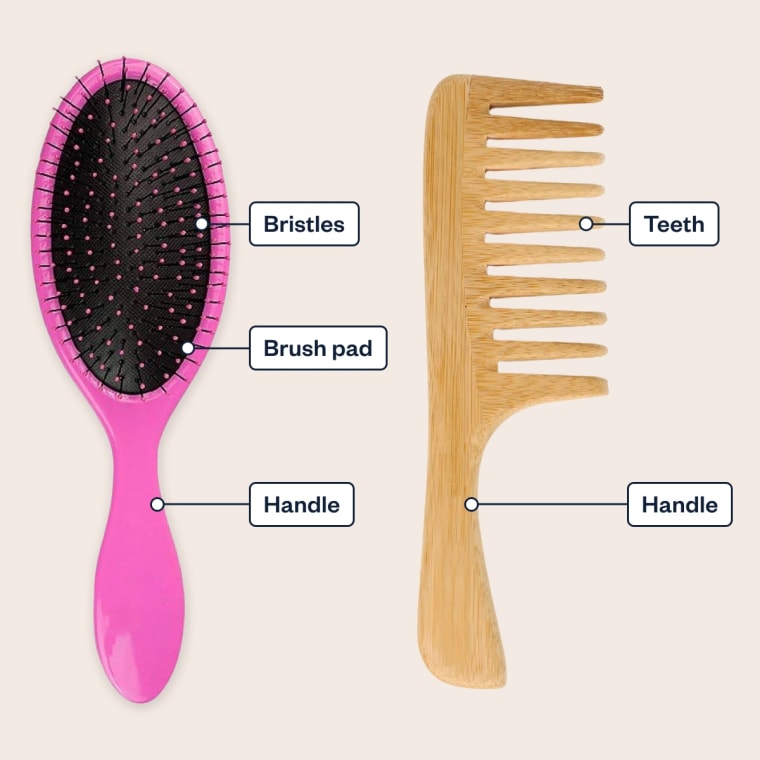
- Bristle/teeth damage. If the bristles on your brush are broken, bent or missing, it may be time to get rid of it, says Cardenas. When the bristles are in this state, they can no longer distribute hair oils properly and can cause hair breakage. Similarly, if the teeth on your comb are missing or broken, it can lead to unnecessary snagging, split ends and overall discomfort on the hair, according to Whiteman.
- Brush pad damage. If the brush pad is cracked or loose, it can tug on the hair instead of gliding smoothly, says Whiteman.
- Frequent cleaning. If your brush or comb is still not clean after a few soaks, there may be too much buildup and debris and it’s likely time for a new one, according to Cardenas.
Meet our experts
At NBC Select, we work with experts who have specialized knowledge and authority based on relevant training and/or experience. We also take steps to ensure all expert advice and recommendations are made independently and without undisclosed financial conflicts of interest.
- Haven Whiteman is a hairstylist and extension specialist at Luxy Hair, an extension hair care brand that offers consultations and hair care advice directly from a team of stylists.
- Jae Manuel Cardenas is a senior stylist at Sally Hershberger NoMad, a hair salon located in New York City.
- Liz Moirano is a hairstylist and owner of Rooted Mane, a hair salon located in Falls Church, Virginia.
Why trust NBC Select?
I’m an associate reporter who covers new product launches, skin care, hair care and more, including recent stories on the best blow dryer brushes and the best leave-in conditioners. For this story, I interviewed three hairstylists to find out how to clean hairbrushes and combs properly. I also included their recommendations for cleaning products as well as highly rated items that met their guidance.
Catch up on NBC Select’s in-depth coverage of personal finance, tech and tools, wellness and more, and follow us on Facebook, Instagram, Twitter and TikTok to stay up to date.


